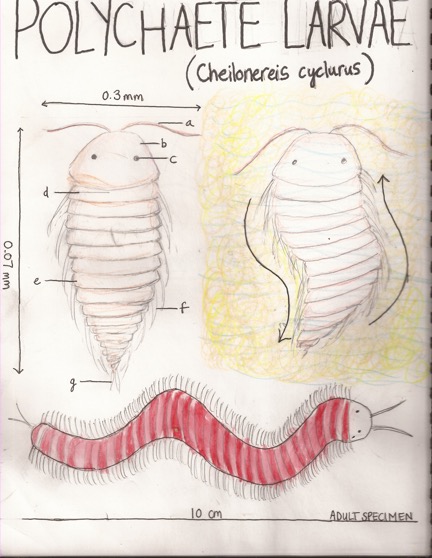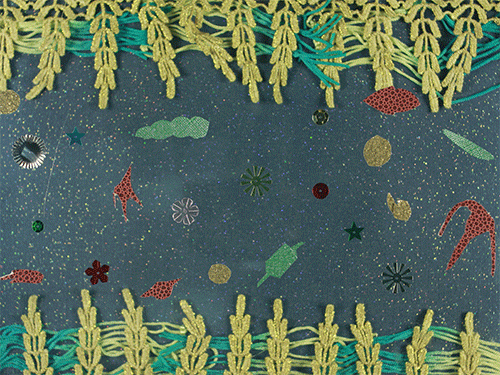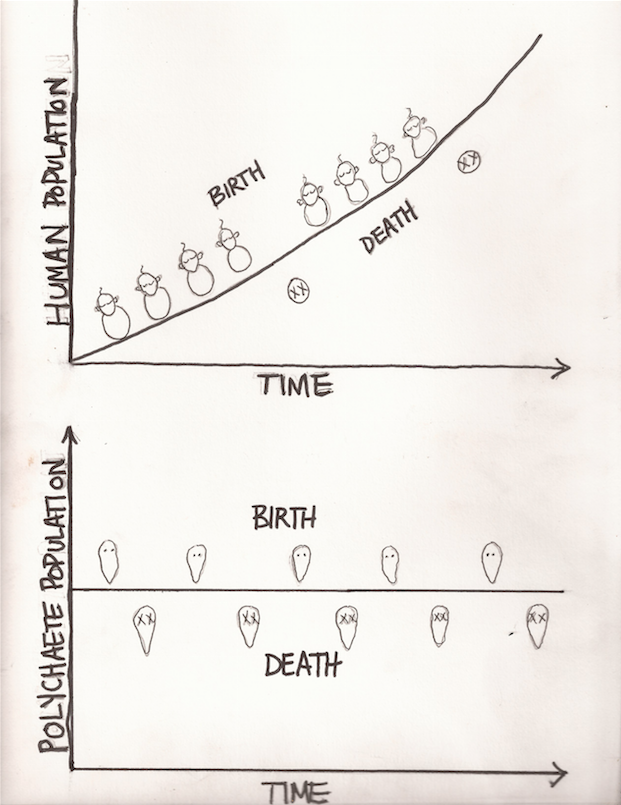
Fig. 2: A sketch of a red-and-white-banded sea nymph larva, 0.3 mm across and 0.07 mm long. Fig. 3: A sketch of the polychaete larva in its natural habitat, moving across the sea floor. Fig. 4: A sketch of the adult polychaete based on a photo from the Pacific Northwest Shell Club website
TAXONOMY:
Kingdom: Animalia
Phylum: Annelida
Class: Polychaeta
DESCRIPTION:
Cheilonereis cyclurus is a red and white banded sea nymph, a type of polychaete worm, of which there are over 10,000 species. They are members of the family Nereididae, and can be referred to as ragworms or clamworms. Polychaetes are identified by their elongated, segmented bodies, which are typically flanked by appendages called parapodia. Small tufts of spines called chaetae protrude from the parapodia, and can be extended and retracted as needed to aid in locomotion. Parapodia can perform multiple functions, including respiration and locomotion. These worms can be found in waters of varying depth, or burrowing in muddy substrate. Polychaete worms of some sort are present in almost every marine setting, including the extreme biome of hydrothermal vents. Polychaetes can live in such contrasting environments because each species has evolved specifically to suit its environment and lifestyle – sedentary polychaetes often have pumping circulatory systems, and others have developed long, feathery protrusions to increase surface area, which is then utilized for respiration.
Polychaetes have well-developed heads, which typically extend over the mouth, which is located on the underside. The jaws and pharynx of polychaetes can be everted to capture and envelop food in one swift movement. Feeding behavior is not consistent within the Nereididae – they can be predators, herbivores, omnivores, surface feeders, suspension feeders, or deposit feeders. Some species of polychaete undergo a process called epitoky when they are ready to breed – the bottom half of their body undergoes a transformation specifically for breeding purposes. The rear half, or the epitoke, is responsible for the entire reproductive process, and the front, or the atoke, is asexual. The epitoke is packed full of eggs and sperm. When the time comes, aligned with the phases of the moon, the epitoke separates from the atoke and floats toward the surface, where all the eggs and sperm burst and swim in different directions.
WHAT CAN WE LEARN FROM THE POLYCHAETE?
The one-time reproduction and subsequent death of the Nereididae could be interpreted in the 21st century as a symbol of a potential response to the issue of overpopulation. If the polychaetes can control their own population, why can’t we? Shying from the extreme of dying after reproduction, the polychaetes could teach us a thing or two about self-regulation. For each polychaete that is born, an old one dies and retains the balance in its population. We humans have no evolutionary safeguard in place to ensure that we do not overpopulate the planet – and so, we do! In some places around the world, limits on reproduction have already been put in place. While many have protested what they consider to be an affront to human autonomy, regulations such as this may soon be one of few options in a world bursting at the seams with human beings. Different species of polychaetes have developed specialized physical characteristics to help them interact with their environment more efficiently. Humans may not be able to breathe through their skin yet, but we can still modify our lifestyles and infrastructure to make our existence sustainable.
ILLUSTRATION KEY:
A – antenna
B – prostomium
C – eyes
D – peristomium
E – setae
F – parapodia
G – anal cirri
REFERENCES:
“Ragworm – Hediste Diverticolor.” The Marine Life Information Network. Web. 18 Nov. 2015. <http://www.marlin.ac.uk/speciesfullreview.php?speciesID=3470>.
Bowling, Brenda. “Nereididae – Bristle Worms (Polychaetes).” Texas Parks and Wildlife Department. Web. 16 Nov. 2015. <http://txmarspecies.tamug.edu/invertfamilydetails.cfm?famnameID=Nereididae>.
Jumars, Peter A., and Fauchauld, Kristin. “The Diet of Worms: A Study of Polychaete Feeding Guilds.” Oceanography and Marine Biology (1979). Print.
Giangrande, Adriana. “Polychaete Reproductive Patterns, Life Cycles and Life Histories: An Overview.” Oceanography and Marine Biology 35 (2005). Print.
Campbell, D. (n.d.). Bristleworms – Polychaeta – Overview – Encyclopedia of Life. Retrieved December 7, 2015.


